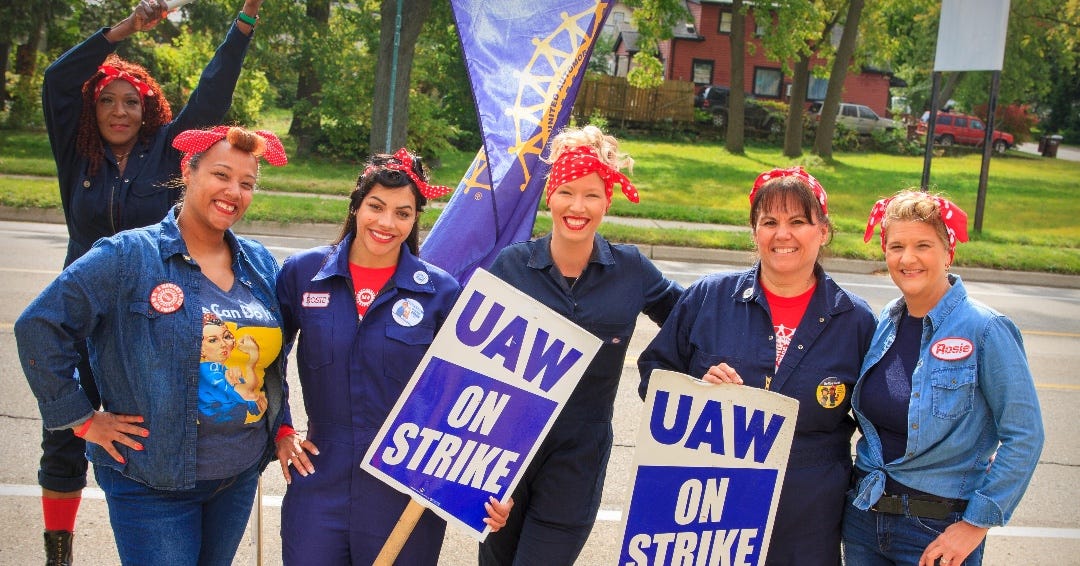What’s in the UAW’s Historic Tentative Agreement With Ford
In yet another break with years past, UAW members at Ford will return to work while the agreement is voted on to increase pressure on GM and Stellantis to make a deal.
By Katie Nixdorf, More Perfect Union
The United Auto Workers announced Wednesday that it reached a groundbreaking tentative labor agreement with Ford. Workers will receive larger raises in this contract than they have over the last 22 years combined. These historic gains are a testament to the power working people have built through this union.
Since the strike began, the value of Ford’s offer increased by 50 percent, according to the UAW. Ford initially proposed a 9 percent wage increase, a 6-year progression to earning the top wage, $12,000 in cost-of-living (COLA) bonuses, and the same 6.4 percent employer 401(k) contribution as the company offered in the 2019 contract.
The new tentative agreement with Ford restores COLA to where it was before 2009, bringing workers’ total wage increase to 33 percent. Wages for starting workers will increase 68 percent to over $28 an hour, while wages for temp workers will increase by 150 percent. The progression to top wage was cut by more than half to 3 years, which hasn’t been the case since before 2009, and Ford’s 401(k) contributions were bumped to 9.5 percent.
Wage increases were one of the last issues to be settled, as the UAW pressed Ford this week to move from 23 percent to 25 percent. The last time workers saw a wage increase of comparable size was when GM workers won 19 percent raises in 1970.
All of this comes after six weeks of negotiations that were history-making in more ways than one.
For the first time, the UAW broke away from what’s known as “pattern bargaining.” Instead of picking a single target company to negotiate a model contract with, the UAW negotiated with all three companies simultaneously, forcing management to compete with each other to give the union a better offer.
Then, for the first time in its history, the UAW struck all of the Big Three automakers at once. This strategy — dubbed the “Stand Up” strike — gave the union flexibility to strategically pressure automakers at key moments.
Since September 15, the strike grew from 12,700 workers at three plants to around 45,000 workers at 46 plants. In its initial phase, UAW president Shawn Fain set weekly deadlines: If there was no movement, more plants were struck; if there was positive movement, the company could be spared.
This pushed negotiations to continue right up until each deadline, with the company sometimes making concessions with just minutes to spare. GM’s historic decision to include its electric vehicle battery plants under the master agreement came after the union threatened to shut down its major Arlington, Texas plant. “I was ready to call on one of GM's biggest and most important plants to stand up and it was that threat that brought GM to the table,” Fain told members in a livestream just minutes after the decision was made.
“We have designed this strategy to increase pressure on the companies, not to hurt them for its own sake, but to move them, to get them to say yes when they want to say no,” said Fain.
Just when the strategy was becoming familiar, the UAW switched its approach again. On October 11th, 8,700 workers at Ford’s Kentucky Truck Plant walked off the job in a surprise escalation. “Moving forward, we will be calling out plants when we need to, where we need to, with little notice,” Fain explained later that week.
Since then, the UAW called on workers from GM's Arlington Plant and Stellantis’ Sterling Heights Assembly Plant in Michigan — each of the company’s largest and most profitable plants — to join the strike.
The UAW is now using the Ford agreement to increase pressure on GM and Stellantis to make a deal. Instead of remaining on strike, UAW members at Ford will go back to work while the agreement is discussed and voted on.
“The last thing [GM and Stellantis] want is for Ford to get back to full capacity while they mess around and lag behind,” UAW Vice President Chuck Browning said in a video announcing the tentative agreement.
Throughout the negotiations, we’ve spoken with UAW members across the Big Three automakers about the issues that matter most to them. We’ll be talking to workers this week to ask them whether or not this contract lives up to those demands.



I think Fain's leadership has been inspiring and instructive.
Having a committed, smart UAW President helps a lot too.